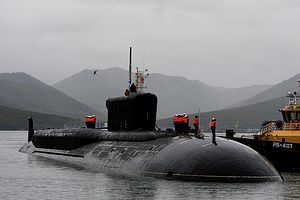Russia is expecting to float out the first advanced variant of the nuclear-powered ballistic missile submarine Project 955A Borei II-class (“North Wind”) aka Dolgorukiy-class in June of this year, Vice Admiral Viktor Bursuk, the deputy commander of the Russian Navy, said in a March 21 statement. The Russian Navy’s newest boomer is expected to be delivered to the service in 2018.
“I believe that no later than June. The delivery, as we spoke with you, will take place in 2018,” Bursuk told TASS news agency. Bursuk’s statement was corroborated by the head of Russia’s state-owned United Ship-Building Corporation, Alexei Rakhmanov. “The first modernized Borei-class lead sub will be delivered to the Navy in 2018. A relevant decision has been made on this score,” he said.
The Borei-class is the new sea leg of Russia’s nuclear triad and is slowly replacing obsolete Soviet-era Project 941 Typhoon-class and Project 667 BDRM Delta IV-class submarines. The Russian Navy intends to operate a total of eight Borei-class boats–three Borei-class and five advanced Borei II-class subs–by the middle of the 2020s. A total of three Borei-class subs have been commissioned to date with one boat, the Yuri Dolgoruky, serving with the Northern Fleet and the remaining two (Alexander Nevsky and Vladimir Monomakh) with Russia’s increasingly more active Pacific Fleet.
The first improved Borei II-class SSBN, christened Knyaz Vladimir, was laid down in July 2012 at the Sevmash shipyards in Severodvinsk, a port city on Russia’s White Sea following a two year delay due to contract disputes, which also pushed back the commissioning date of the ship from 2017 to 2018.
What makes Russia’s new boomer so deadly is not its hydrodynamically efficient hull, or its pump-jet propulsion, but rather its nuclear payload as I noted elsewhere (See: “Russia Will Start Constructing New Ballistic Missile Submarine in December”):
In comparison to the Borei-class, Borei II-class submarines are fitted with four additional missile tubes, boast smaller hulls and cons, and feature improved acoustics and lower sound levels, next to a number of other technical improvements.
Both variants of Borei-class subs will be armed with Bulava (RSM-56) intercontinental ballistic missiles (ICBMs). The Borei-class will be capable of carrying up to 16 Bulava ICBMs, whereas the improved Borei II-class can carry up to 20 ballistic missiles.
The improved variant of the Borei-class will be capable of launching 96-200 hypersonic, independently maneuverable warheads, yielding 100-150 kilotons apiece.
Armed with the maximum number of Bulava ICBMs, the advanced Borei II-class can reportedly carry the same number of warheads than the entire nuclear arsenal of the United Kingdom. However, the Bulava ICBM has suffered a number of test failures since its official induction. For example, during the last test firing of the missile in September 2016, one Bulava self-destructed in flight.
































